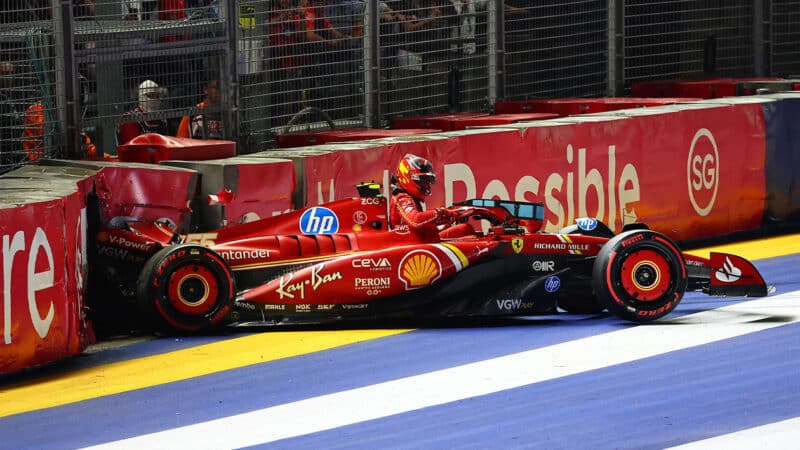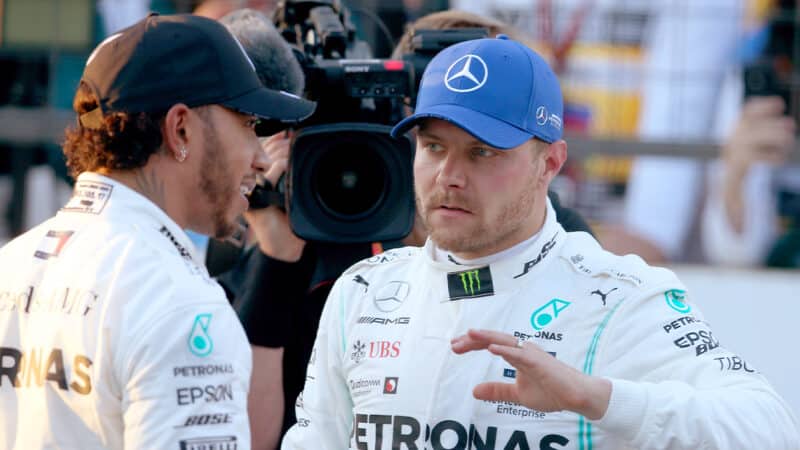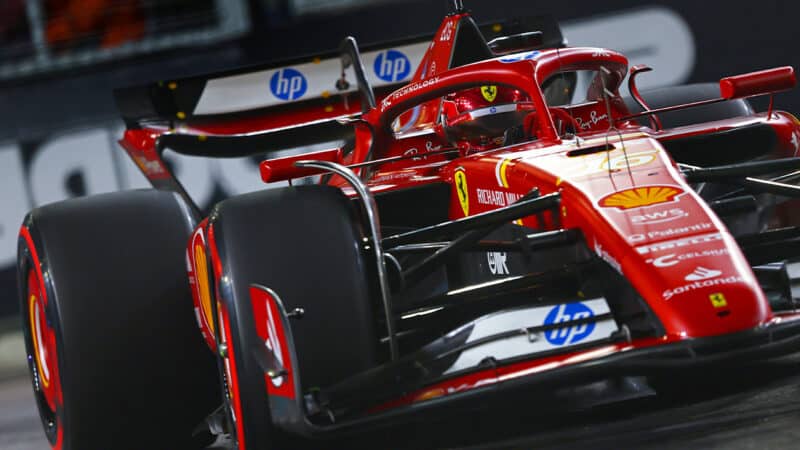Leclerc had a lot of tyre-cooling waiting to do. Did that lose him all the tyre temperature he’d just gained by staying longer with the blankets on? These are the sorts of margins Ferrari was playing with. Despite the big gap he’d given Alonso, Leclerc was almost up with him by Turn 16 – and was obliged to back off again, late in the lap. He then had to wait a further few seconds so as not to impede the end of Nico Hülkenberg’s timed lap. As he begins the first Q3 lap he can feel the front tyres are not fully up to temperature, he has to back off a little on the exit and take Turn 2 cautiously. There’s probably more than 0.1sec of lost lap time immediately. But then there’s a red flag. Sainz has crashed, caught out by the same combination of low tyre temps and having to wait to avoid impeding (in this case Oscar Piastri). As Sainz went to get back on the gas through the final fast double-apex left-hander, the rear wheels spun up over a bump and threw the Ferrari backwards into the wall. So, neither Ferrari with a time on the board, Leclerc having it all to do on the next lap. That late pitlane leave had really bitten them so far.
Time was getting tight for the final runs once the session was restarted and Leclerc was the fifth car out – but again Alonso was released in his path. Again his out-lap was compromised. Leclerc’s default is always to attack. He had to assume his tyres were going to be ready as he approached Turn 1. They weren’t. He ran a compromised line out of there and ran beyond track limits at Turn 2 as a result. Time deleted. Ferrari P9 and P10 on the grid.

Sainz steps out of his cold-tyred Ferrari after qualifying crash
Grand Prix Photo
With the benefit of hindsight, Ferrari got it wrong. But only because it was trying to transcend the actual level of its car around here.
Scratching like this doesn’t always go wrong. Sometimes it can put the slower car in control of the race. Let’s go back to Baku 2019. Ferrari was way faster than Mercedes around here. But Leclerc – by far the fastest throughout the weekend – had crashed out in Q2. That still left Sebastian Vettel in a car faster than the Mercedes. But only by a couple of tenths at best. Mercedes were scratching but for Q3 had a plan.
Here’s how we called it in the report at the time:
The plan at Mercedes had been hatched earlier that morning; because the tow on that final Caspian straight is so valuable here (anything between 0.3 and 0.6sec), they wished to avoid the usual final Q3 scenario of everyone waiting for Mercedes to go out first, which potentially could see Ferrari benefit from Merc’s tow. One of the Mercs would be towed by the other, but the lead one would try to pick up a tow from another team’s car, while trying not to give Ferrari a tow. But how to arrange that on the crucial final runs? The dummy. Valtteri Bottas and Lewis Hamilton left early, just like usual. Three cars responded – those of Lando Norris, Antonio Giovinazzi and Sebastian Vettel – to line up nose-to-tail behind the Mercs up the pitlane. But then Bottas and Hamilton moved hard left into the practice start lane… and stopped. “Were you guys doing dummy starts, or did you just stop?” asked Vettel afterwards, knowing full well the answer. “Mmm?” replied Hamilton in mock innocence. “We just dummied you basically.”
“Clutch calibration,” offered Bottas. “Yeah, definitely clutch calibration,” agreed Hamilton.
Bottas, benefitting from Norris’s tow, took pole. Hamilton, getting a tow from Bottas, lined up alongside him. Vettel, in the faster car but without the tow’s 0.3sec, was third, 0.1sec off the Mercs.

Mercedes drivers after qualifying in Baku ’19: Hamilton chose the running order but was compromised by being behind Bottas
Charles Coates/Getty Images
So Merc had scratched itself onto the front row against a faster car on the day, the foundations of a 1-2 in the race, Bottas winning. But the Q3 manoeuvering had implications upon the order within Mercedes.
Bottas let Norris go, so as to get enough distance on the McLaren that he wouldn’t be disturbed by its wake in the early part of the lap but could get its tow at the end. Hamilton in turn had to let Bottas go, which dropped his tyres even further out the window. “I had moments at Turns 1 and 3 as a result,” he reported.
There was an intense bit of discussion between the Mercedes drivers in the collecting area, almost certainly about how Hamilton had been compromised on the tyre prep lap – but Bottas appeared to give him short shrift. It had been Hamilton’s turn this weekend to decide the running order between them and it was he who’d decided Bottas should run ahead (obviously with the intention of picking up Bottas’s tow). As it turned out, of course, that worked against Hamilton.
“We need to have a cleaner weekend,” said Vasseur after the last Sunday’s race, in which Leclerc came through to fifth, Sainz to seventh. For sure it was a weekend which could have gone better. But sometimes you can get it wrong for all the right reasons.



